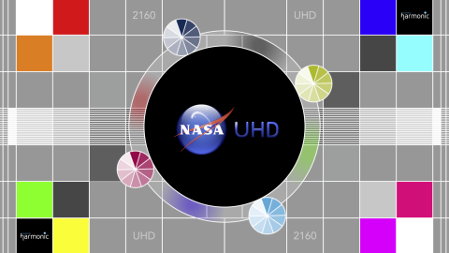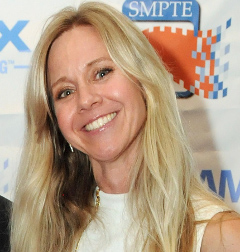Encoding Races Toward a 4K Future
ALEXANDRIA, VA.—With some program providers now streaming content in 4K/UHD resolution, and over-the-air broadcasting trials of the next generation of ATSC transmission including 4K demos, you might think that encoders to make UHD magic happen are signed, sealed and delivered. Not so fast, however—it’s complicated and a lack of approved standards is making the trip to the clarity of 4K a little murky.
These products are coming though, particularly since rapid evolution in the area of consumer 4K displays has put the 4K viewing end of the chicken-and-egg scenario into homes across the U.S. Viewers have shown that they are not chicken when it comes to shelling out for the latest high-resolution displays, and they are now waiting for program producers to lay the golden eggs of 4K content and delivery.
Those producers need the right encoders to process that content, and that’s where this story begins.

Last fall, NASA partnered with Harmonic to launch the NASA TV UHD channel.
“The 4K/UHD bandwagon has been steadily gaining momentum, led by consumer purchases of UHD televisions and content providers’ broad production in 4K [enabled by cost-effective 4K cameras],” said Peter Alexander, chief marketing officer for San Jose, Calif.-based Harmonic. “There has been growing demand from both sides for the services to connect the two, enabling broadcast delivery of UHD, but the technical and commercial viability models are not yet proven. Our partnership with NASA allows for the delivery of 4K content over a new UHD delivery workflow and on a new type of ‘ambient’ channel that does not compete with the broadcasters.” (Alexander is referring to last fall’s launch of the NASA TV UHD channel. NASA uses an end-to-end video delivery system from Harmonic to deliver linear 2160p60 video content.)
EARLY IMPLEMENTATIONS
These early implementations rely on standards that are still evolving, which means that each studio and delivery network is using encoders and software that are proprietary to that system, right down to the set-top box used to play the content onto a 4K display. Two codecs prominently mentioned with respect to 4K/UHD encoding are HEVC and VP9; VP9 is a royalty-free codec being developed by Google, while HEVC (High-Efficiency Video Coding) is being developed by an industry-wide effort under the organization of the ITU. HEVC is sometimes referred to as H.265 and MPEG-5.
Since VP9 is under the domain of one company, it was faster to get finalized and released to users. Companies including Nvidia and Microsoft are already using it in various products, and VP9 is supported by browsers such as Mozilla and Chrome. YouTube supports 4K video and uses the VP9 codec for that service (as might be expected, since Google owns YouTube).
The professional video industry's #1 source for news, trends and product and tech information. Sign up below.
HEVC has yet to be finalized, particularly with respect to high dynamic range and wider color gamut features. Developments have been coming quickly over the past few months but there are still issues to be resolved.

Bruce Devlin
“The licensing of the codec is still unclear since the December updates to the rules,” said Bruce Devlin, chief media scientist for France-based Dalet. “The majority of decoders are still software oriented and the sweet spot of ‘4K distribution via OTT’ hasn’t quite taken off due to a combination of factors including the average domestic bandwidth available, the compression ratios of today’s encoders and availability of content.”
The inexorable move to 4K delivery—either online or OTA broadcast—means more than just 4K resolution, and vendors are working to support features such as high dynamic range and wider color gamut.

Keith Wymbs
“4K UHD broadcasts are already benefiting from the wider 10-bit color gamut supported by HEVC,” said Keith Wymbs, chief marketing officer for Portland, Ore.-based Elemental Technologies. “For example, high dynamic range creates a more noticeable difference in images for consumers compared to Ultra HD 4K resolution alone. Software-based video processing solutions from Elemental support HEVC’s efficiency gains and picture quality advancements.”
DIFFERENT TECHNOLOGIES
In the discussion surrounding encoding 4K video, it should be noted that there are different technologies used to move 4K video over IP networks, as opposed to preparing it for broadcast or online distribution. Grass Valley builds 4K IP video products that can be used for point-to-point IP distribution, such as a production truck to a studio. At the 2015 NAB Show, the Montreal-based company announced support for TICO, a new lightweight compression technology developed by intoPIX, which enables 4K UHD to be transported over legacy SDI infrastructure and modern IP production and contribution networks.

Sara J. Kudrle
“With a light mezzanine compression, such as TICO, which can be either visually or mathematically lossless depending on the compression ratio used, the 12 Gbps 4K signal can be made to fit [onto an IP network], said Sara J. Kudrle, product marketing manager for infrastructure, monitoring and control at Grass Valley. “TICO compression is very fast and lightweight, and can be used for live studio or truck applications, with only a few lines of delay. As TICO is generally a 4:1 compression, 4K/60 and 4K/120 will fit into a 10 GigE pipe.”
The new encoders for HEVC are often thought of as being specific for 4K distribution, but the reality is their efficiency is also used to free up spectrum now filled with signals encoded with H.264 and even MPEG-2 processors.
“HEVC encoding is not limited to 4K/UHD. Our encoders support HEVC encoding for HD/SD sources as well, with bandwidth savings of 30-50 percent,” said Abdullah Merei, compression product manager for Evertz in Burlington, Ont. “The real challenge is that program providers need to provide their customers with set-top boxes that support HEVC decoding.”
Others concur on the importance of freeing up bandwidth, which will probably be modest at the start and get more efficient over time.
“Although HEVC is the only practical way to deliver 4K/UHD to the home, it does offer significant reductions in bit-rate (vs. H.264, for example) that translates to more channels for a given transponder bandwidth,” said Paul Turner, vice president of enterprise product management for Telestream in Nevada City, Calif. “No special tools are required to make use of the new codec [except the codec itself, of course]—but once again, the current licensing situation is a fundamental barrier to widespread use of the technology. Bit-rate savings of up to 50 percent are theoretically possible, but customers should realistically expect to see savings in the 25-30 percent range at present. This should improve as the codec matures.”
All the manufacturers contacted for this article noted that software-based encoders and decoders, which can be updated with new features after they are put into service, are necessary for a successful rollout of UHD broadcasting and online distribution.
“We are at the beginning of 4K/UHD distribution,” Merei said. “To be able to flexibly handle technologies that are currently being finalized [high dynamic range, for example], you need to invest in software-defined products. We also need to define what 4K actually means. Does it include high dynamic range? Wider color gamut? Higher frame rate? 4K is not just a higher resolution.”
Bob Kovacs is the former Technology Editor for TV Tech and editor of Government Video. He is a long-time video engineer and writer, who now works as a video producer for a government agency. In 2020, Kovacs won several awards as the editor and co-producer of the short film "Rendezvous."

